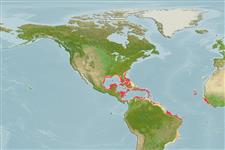Teleostei (teleosts) >
Anguilliformes (Eels and morays) >
Muraenidae (Moray eels) > Muraeninae
Etymology: Gymnothorax: Greek, gymnos = naked + Greek, thorax, -akos = breast (Ref. 45335).
More on author: Kaup.
Environment: milieu / climate zone / depth range / distribution range
Ecology
Marine; reef-associated; depth range 0 - 60 m (Ref. 9710), usually 0 - 35 m (Ref. 40849). Subtropical; 41°N - 26°S, 99°W - 5°W
Western Atlantic: Bermuda and southern Florida, USA to the Antilles (Ref. 26340) and southeast Brazil (Ref. 42064). Eastern Atlantic: St. Paul's Rocks (Ref. 13121), Cape Verde, Ascension and St. Helena islands (Ref. 4450). Also mid-Atlantic islands (Ref. 26938).
Size / Weight / Age
Maturity: Lm ? range ? - ? cm
Max length : 70.0 cm TL male/unsexed; (Ref. 4450); common length : 40.0 cm TL male/unsexed; (Ref. 5217)
Short description
Morphology | Morphometrics
Dark brown with numerous yellow dots, smallest on head and largest toward end of tail where they are irregular and confluent (Ref. 13442). Stout moray with a short blunt snout. Tip of tail always pale, usually deep yellow in life. Posterior nostril in short tube (Ref. 26938).
A benthic and solitary species (Ref. 26340) inhabiting coral reefs and rocky shorelines. Usually at depths of 60 m (Ref. 26938). One of the most common and easily recognized morays of the West Indian reefs, active during the day and sometimes hunting together with other predators (Ref. 42064). This species has been called Muraena miliaris (Ref. 26938).
Life cycle and mating behavior
Maturity | Reproduction | Spawning | Eggs | Fecundity | Larvae
Robins, C.R., R.M. Bailey, C.E. Bond, J.R. Brooker, E.A. Lachner, R.N. Lea and W.B. Scott, 1991. Common and scientific names of fishes from the United States and Canada. Am. Fish. Soc. Spec. Publ. (20):183 p. (Ref. 3814)
IUCN Red List Status (Ref. 130435)
Threat to humans
Harmless
Human uses
Fisheries: minor commercial; aquarium: commercial
More information
Age/SizeGrowthLength-weightLength-lengthLength-frequenciesMorphometricsMorphologyLarvaeLarval dynamicsRecruitmentAbundanceBRUVS
ReferencesAquacultureAquaculture profileStrainsGeneticsElectrophoresesHeritabilityDiseasesProcessingNutrientsMass conversion
Tools
Special reports
Download XML
Internet sources
Estimates based on models
Preferred temperature (Ref.
123201): 24.6 - 28, mean 27 °C (based on 498 cells).
Phylogenetic diversity index (Ref.
82804): PD
50 = 0.5000 [Uniqueness, from 0.5 = low to 2.0 = high].
Bayesian length-weight: a=0.00098 (0.00061 - 0.00158), b=3.24 (3.11 - 3.37), in cm total length, based on LWR estimates for this species & Genus-body shape (Ref.
93245).
Trophic level (Ref.
69278): 3.9 ±0.63 se; based on food items.
Resilience (Ref.
120179): Medium, minimum population doubling time 1.4 - 4.4 years (Preliminary K or Fecundity.).
Fishing Vulnerability (Ref.
59153): Moderate to high vulnerability (48 of 100).
Nutrients (Ref.
124155): Calcium = 21.5 [10.4, 54.2] mg/100g; Iron = 0.462 [0.251, 0.942] mg/100g; Protein = 19.4 [17.2, 21.9] %; Omega3 = 0.172 [0.073, 0.489] g/100g; Selenium = 20 [10, 43] μg/100g; VitaminA = 42 [12, 149] μg/100g; Zinc = 0.652 [0.423, 0.992] mg/100g (wet weight);
